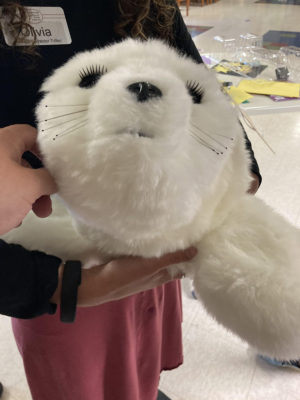In memory care, robotic pets are used in many ways to improve quality of life. With a lifelike look and feel, robotic dogs, cats and other animals can be a soothing diversion during times of stress. Notably, robotic pets also have been shown to improve brain function and prevent cognitive decline.
Studies of the PARO robot, an adorable therapeutic seal developed in Japan, have shown that at least half of the elderly with Alzheimer’s disease and similar cognitive decline experience improved brain function when interacting with the animals. In many cases, the results are similar to those gained in animal therapy.

That is great news, because two of the PARO robotic seals are now at CHCC!
Thanks to a LeadingAge grant, CHCC has been able to purchase two of the cute robots. One (named Sammy) is reserved for our memory care residents, and the other (named Harper) is being used in our therapeutic recreation department. The grant is similar to the one used recently to start an outdoor bicycling program for residents.
Dr. Sandra Petersen, from the University of Texas at Tyler, has begun training CHCC staff members on the use of the robots for providing therapeutic care to those who live here. PARO robots were first released in 2003; CHCC’s will be the eighth generation of the successful tool.
The sophisticated new seals have been added to the robotic dog and cat already in use.
“We have observed the ‘Joy For All’ companion pets provide residents with many moments of comfort and joy over the past couple of years,” said Josh Friesen, a social worker at CHCC. “With our staff participating in specialized training provided through the grant, we anticipate even greater therapeutic benefits for our residents as they are introduced to the PARO robots!”
According to the company’s website, PARO robots have sensors for touch, light, sound, temperature and posture. The robot can distinguish between light and dark, and it knows when it is being stroked or petted. The posture sensor helps the robot know when it is being held, and it also can sense the direction of voices and recognize its name and common greetings.
The robots also pick up cues from the way they’re treated, learning to react in ways that generate positive responses. The animal can move its head and legs and make sounds — even imitating the voice of a baby harp seal — among other actions.
To read more about how technology is put to good use in memory care at CHCC — including community television, audiobooks and music — visit https://chcclynden.org/technology-provides-moments-of-joy-in-memory-care/.
For more on PARO robotic pets, visit the company’s website at http://www.parorobots.com/. A video of the robot in action at a care facility in California is available here.
